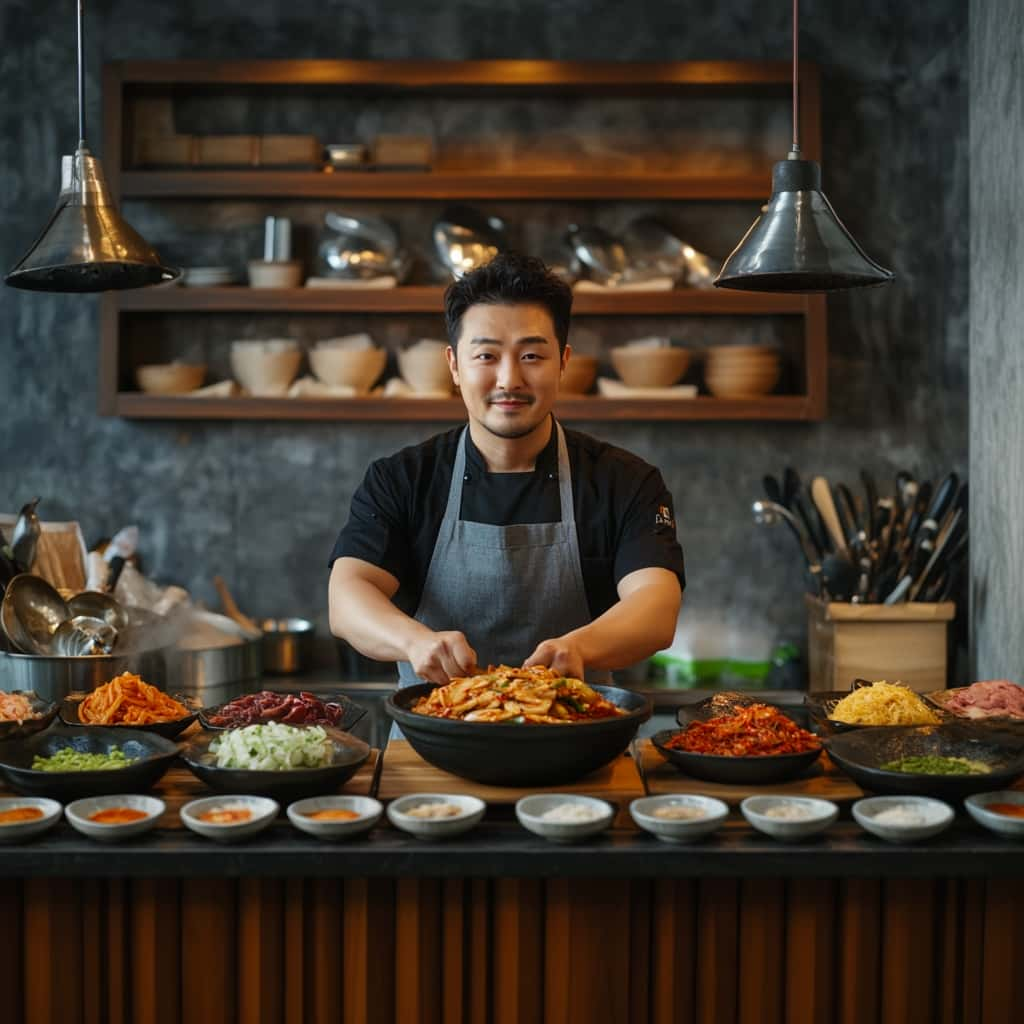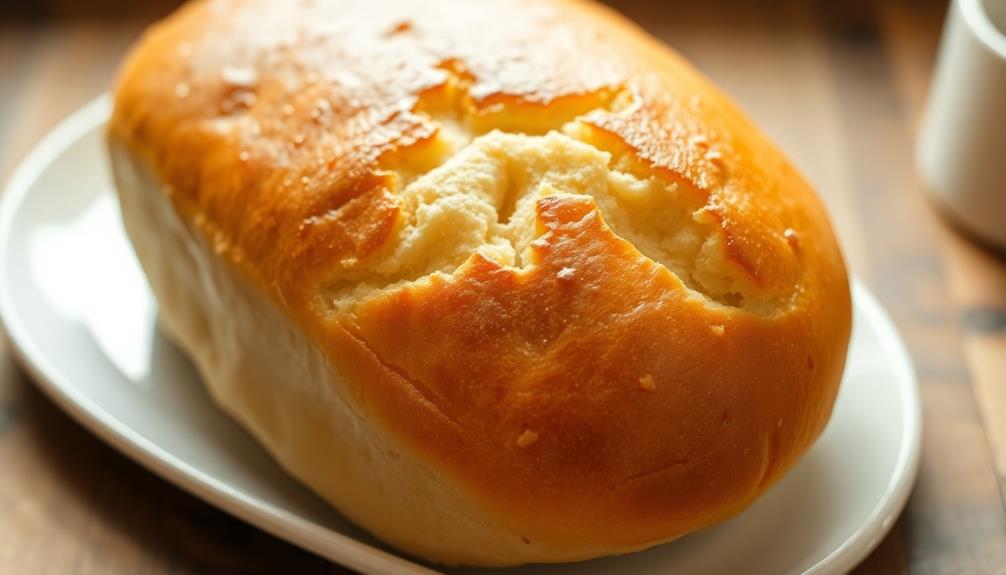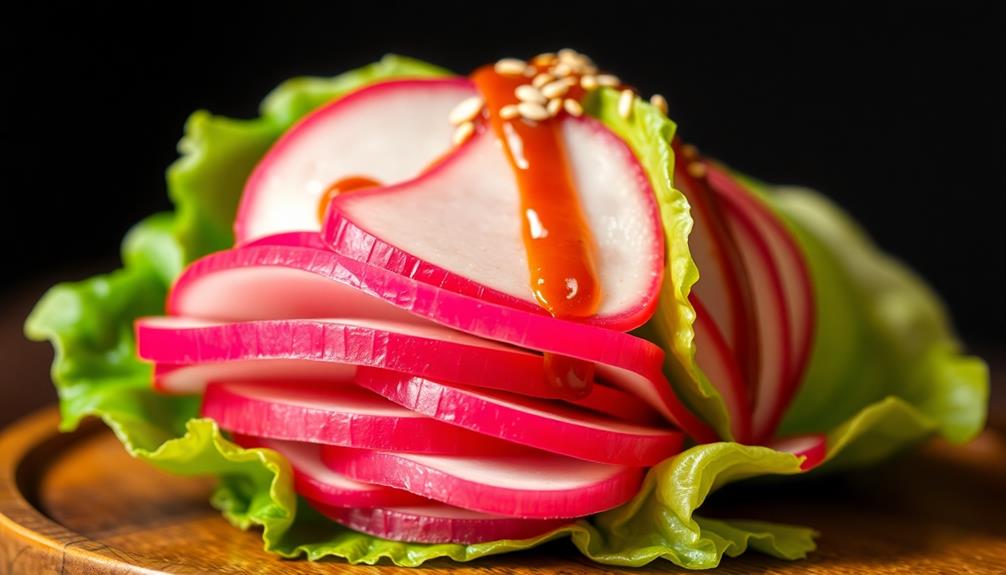Kimbap, those yummy seaweed rice rolls, are like little flavor-filled gifts wrapped in nori! You'll love making them with rice, veggies like carrots and spinach, and maybe some tasty beef or crab. Just cook your rice, lay it on a sheet of nori, add your fillings, and roll it up tight using a bamboo mat. Slice it into bite-sized pieces, and you've got a fun meal perfect for sharing with friends or family! Plus, you can mix and match your favorite ingredients. Stick around, and you'll discover even more fun ways to enjoy this delightful dish!
Key Takeaways
- Kimbap originated in the 16th century as a portable meal for farmers and has evolved with various regional fillings over time.
- Core ingredients include short-grain rice, nori, and fillings like pickled radish, carrots, spinach, and omelet, with optional proteins.
- Rolling kimbap involves placing rice and fillings on nori, rolling tightly with a bamboo mat, and sealing the edges with water.
- Slice kimbap with a wet knife to achieve clean cuts, serving bite-sized pieces on a plate for sharing.
- Kimbap is ideal for gatherings, picnics, and school lunches, offering a customizable and enjoyable culinary experience.
History
Have you ever wondered how kimbap, the beloved Korean seaweed rice roll, came to be? The history of kimbap is both fascinating and delicious!
It's believed that kimbap originated during the Joseon Dynasty, around the 16th century. Back then, people needed portable meals for picnics and long journeys. So, they started rolling rice and tasty ingredients in seaweed, making it easy to eat anywhere.
Originally, kimbap was just a simple meal for farmers and travelers. But as time went on, it evolved, and different regions added their own unique ingredients. For example, some folks love adding pickled vegetables, while others might include beef or fish. This versatility is what makes kimbap so special!
Kimbap became a popular dish during the Japanese occupation in the early 20th century. People began to enjoy it at picnics and festivals, turning it into a beloved comfort food.
Today, you can find kimbap in restaurants or even at convenience stores, ready for you to munch on. So, next time you take a bite of kimbap, remember that you're enjoying a tasty piece of history! Isn't that exciting?
Recipe
Kimbap, also known as Korean seaweed rice rolls, is a popular and versatile dish that can be enjoyed as a snack or a meal. Traditionally filled with a variety of ingredients, Kimbap is a delightful combination of seasoned rice, fresh vegetables, and proteins, all wrapped in a sheet of seaweed. It's perfect for picnics, lunchboxes, or simply as a healthy option for any meal. Delicious Korean gimbap recipe can be customized to suit individual tastes, with fillings such as pickled radish, carrots, spinach, and seasoned beef or spam. The possibilities are endless, and the result is always a satisfying, flavorful treat. Whether enjoyed on its own or paired with a hot bowl of soup or a spicy dipping sauce, Kimbap is sure to please even the pickiest of eaters.
The beauty of Kimbap lies in its flexibility; you can customize the fillings according to your taste preferences or dietary needs.
To prepare Kimbap, you'll want to start with perfectly seasoned rice, which forms the foundation of this dish. The rice is typically mixed with sesame oil and salt to enhance its flavor. As you gather your filling ingredients, think about a balance of flavors and textures, such as crunchy pickled radish, savory egg, or tender spinach.
With a little practice, rolling Kimbap can become a quick and enjoyable task, making it a great dish to share with family and friends.
Ingredients:
- 2 cups short-grain rice
- 2 1/2 cups water
- 2 tablespoons sesame oil
- 1 teaspoon salt
- 5 sheets of nori (seaweed)
- 1 cup pickled radish, cut into strips
- 1 cup julienned carrots
- 1 cup blanched spinach
- 2 eggs, beaten and cooked into an omelet, sliced
- 1/2 cup cooked beef or crab meat (optional)
- Sesame seeds for garnish
To cook Kimbap, start by rinsing the rice under cold water until the water runs clear, then soak it for about 30 minutes. Drain the rice and combine it with 2 1/2 cups of water in a rice cooker or pot. Cook the rice until tender, then let it sit covered for an additional 10 minutes.
Once cool, mix the rice with sesame oil and salt in a large bowl. Place a sheet of nori on a bamboo mat or clean surface, spread a thin layer of rice over it, leaving a small border at the top. Layer your choice of fillings in the center, then roll the nori tightly from the bottom to the top, sealing the edge with a little water.
Repeat with the remaining sheets and fillings, then slice the rolls into bite-sized pieces.
When making Kimbap, feel free to get creative with your fillings; you can include any combination of vegetables, proteins, or even fruits. To make the rolling process easier, ensure your hands are slightly wet when handling the rice to prevent it from sticking.
Additionally, using a sharp knife to cut the rolls will provide cleaner edges, making your Kimbap not only taste great but look appealing as well. Enjoy your homemade Kimbap fresh, or store it in an airtight container for later!
Cooking Steps
Now, let's get ready to make some delicious kimbap!
Start by gathering all your ingredients and laying them out, because a well-prepared workspace makes rolling so much easier.
You'll want to layer your rice evenly, add your favorite fillings generously, and then roll it up tightly—trust me, the taste is worth it!
Step 1. Prepare Ingredients for Rolling

Gathering fresh ingredients is essential for creating delicious kimbap. First, you'll need some cooked rice, which should be warm but not too hot—this helps it stick together.
Next, grab sheets of seaweed, also known as nori, to wrap your tasty fillings. Vegetables like cucumbers, carrots, and spinach are fantastic choices. You can even sneak in some pickled radish for a zesty kick!
Don't forget about protein! You can use slices of egg omelet, cooked chicken, or even tofu if you prefer a vegetarian option. Make sure to slice everything into long, thin strips. This way, they'll fit perfectly when you roll your kimbap.
Lastly, have a small bowl of sesame oil or soy sauce handy for brushing on the seaweed, adding extra flavor. Remember, fresh ingredients not only taste better but also make your kimbap look colorful and appetizing.
Now that you have everything prepped, you're ready to roll! Just think of all the yummy combinations you can create. Get excited, and let your imagination run wild with those flavors!
Step 2. Layer Rice Evenly on Seaweed
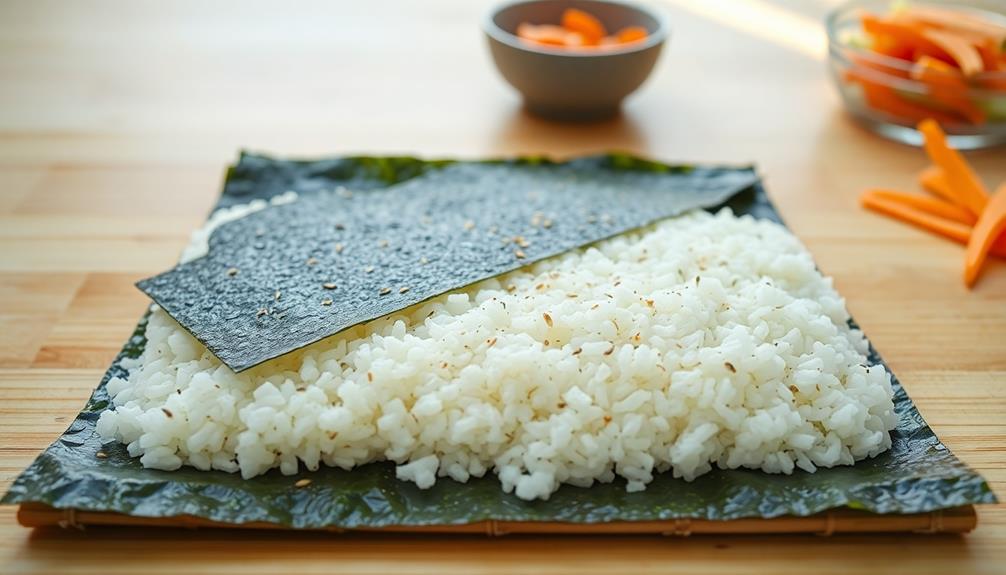
With your ingredients prepped and ready, it's time to layer the rice evenly on the seaweed.
Start by grabbing a sheet of nori, shiny side down, and place it on your bamboo mat or clean surface. Next, take a scoop of warm, sticky rice—about a cup will do—and spread it over the nori, leaving about an inch of space at the top. This gap is super important because it'll help seal your roll later!
Using your fingers or a spatula, gently press the rice down so it covers the nori in a thin, even layer. Try to make it about half an inch thick; if it's too thick, your kimbap might be a bit of a challenge to roll.
Don't worry if it feels a little messy; that's all part of the fun!
If you like a little extra flavor, sprinkle some sesame seeds or a dash of salt over the rice. It'll give your kimbap a tasty twist that everyone will love.
Once your rice is layered just right, you're all set to move on to the next exciting step—adding those delicious fillings!
Step 3. Add Fillings Generously
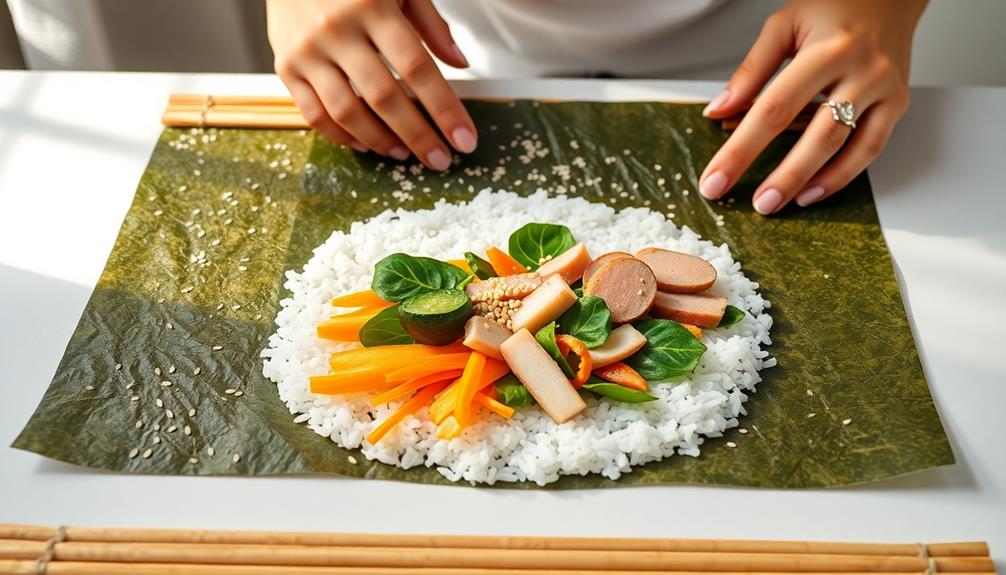
Once the rice is perfectly layered, it's time to add your fillings generously. This part is where you can really let your creativity shine! Think about what you love to eat. You can use all sorts of ingredients like cucumber sticks, carrots, pickled radish, or even cooked eggs.
Lay these fillings in a neat line across the rice, making sure they're evenly spaced. You want every bite to be delicious, right?
Don't be shy! The more fillings you add, the tastier your kimbap will be. Just remember not to overstuff it, since you'll need to roll it up later. Aim for a colorful mix of ingredients, as it makes your kimbap not only yummy but also pretty to look at.
If you're feeling adventurous, you can even add a little bit of cooked meat or tofu for protein.
Once you've got your fillings lined up, take a moment to admire your work. It's like a rainbow of flavors waiting to be wrapped and enjoyed!
Step 4. Roll Tightly and Securely
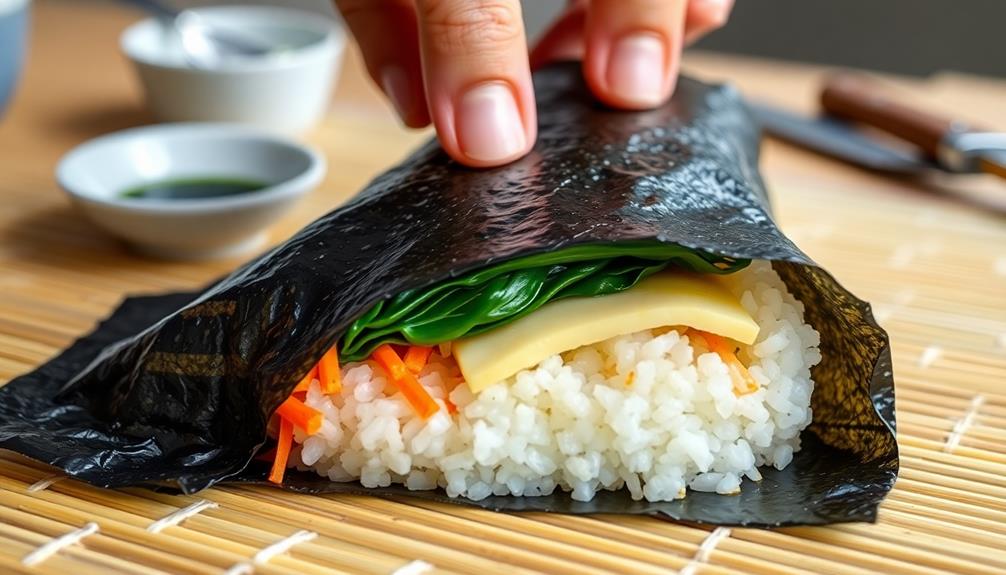
To roll your kimbap tightly and securely, start at one edge of the bamboo mat and gently lift it over the fillings. Make sure you're holding the mat firmly with one hand while using the other to keep the fillings in place. As you roll, apply a little pressure—think of it as giving your kimbap a cozy hug! This helps keep everything together and prevents the fillings from slipping out.
Continue rolling, moving slowly and steadily. Don't rush; you want to create a nice, even cylinder. If you notice any gaps, gently press them together with your fingers. Once you reach the other edge of the seaweed, you can use a bit of water to seal it shut. It's like magic!
Now, here's a fun tip: if you roll it too loosely, your kimbap might fall apart later, and nobody wants that!
Step 5. Slice Into Bite-Sized Pieces

Now that you've rolled your kimbap tightly and secured it, it's time to slice into bite-sized pieces! This part is super fun and helps make your kimbap look extra delicious.
Grab a sharp knife, and remember to wet it slightly with water. This little trick helps prevent the rice from sticking to the knife, making your slices cleaner and prettier.
Start at one end of your roll and gently press down while slicing. Try to cut the roll into pieces that are about an inch wide. If you push too hard, you might squish the filling out, so be gentle!
After you've made the first slice, keep going until you reach the other end.
You'll end up with lovely, round pieces that are perfect for sharing. Arrange them on a plate, and you can even add some soy sauce or pickled radish on the side for dipping.
Your friends and family will be impressed by your skills! So, gather everyone around, and enjoy your tasty creation. Remember, kimbap isn't just a meal; it's a fun experience to share with others!
Happy munching!
Final Thoughts
Kimbap is more than just a meal; it's a delightful experience that brings people together. Whether you're enjoying it at a picnic, a family gathering, or even a fun day at school, kimbap sparks joy and laughter.
You get to choose your favorite fillings, like crunchy carrots, creamy avocado, or tasty bulgogi, making it a meal that's all about what you love.
Making kimbap can be a fun family activity, too! You can roll it up together, each person adding their favorite ingredients.
Plus, it's super easy to pack for lunch, and it stays fresh without making a mess. Who wouldn't want to eat a colorful roll of happiness?
Frequently Asked Questions
Can I Make Kimbap With Gluten-Free Ingredients?
Absolutely, you can make delicious dishes using gluten-free ingredients! Just swap out any wheat-based components for gluten-free alternatives. Experiment with rice, vegetables, and proteins to create a satisfying meal that fits your dietary needs.
How Long Does Homemade Kimbap Stay Fresh?
Homemade rolls generally stay fresh for about one day if stored properly in the fridge. After that, they can become soggy or lose their flavor, so it's best to enjoy them sooner rather than later.
What Are Popular Variations of Kimbap?
You'll find plenty of popular variations, like tuna, beef bulgogi, or vegetable kimbap. Each one offers a unique flavor combination, so don't hesitate to try different fillings to discover your favorite! Enjoy experimenting!
Is Kimbap Suitable for Vegetarians or Vegans?
Yes, you can enjoy it as a vegetarian or vegan option! Just ensure you choose fillings like vegetables, tofu, or pickled radish, and avoid any meat or seafood ingredients. It's delicious and satisfying!
Where Can I Find Kimbap in the U.S.?
You can find kimbap at Korean restaurants, grocery stores with international sections, or specialty Asian markets across the U.S. Check local listings or apps for nearby places that serve this delicious dish. Enjoy exploring!


